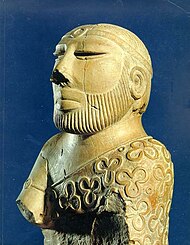| History of Khyber Pakhtunkhwa |
|---|
 |
| History of Pakistan |
| History of Pakistan |
|---|
 |
| Timeline |
The History of Khyber Pakhtunkhwa refers to the history of the modern-day Pakistani province of Khyber Pakhtunkhwa.
The earliest evidence from the region indicates that trade was common via the Khyber Pass; originating from the Indus Valley Civilization. The Vedic culture reached its peak between the 6th and 1st centuries B.C under the Gandharan Civilization, and was identified as a center of Hindu and Buddhist learning and scholarship.[1]
Following Alexander the Great's invasion, the region became part of the Mauryan Empire, followed by the Indo-Greeks, Indo-Scythians and Indo-Parthians.
The region of Gandhara reached its height under Kushan Empire in 2nd and 3rd century AD. Over time the Turk Shahis managed to gain control of the region and ruled starting from around the sixth century, but were later overthrown by the Hindu Shahis.[2] The Hindu Shahis were finally destroyed after the defeat of King Jayapala in A.D 1001 by the Ghaznavids led by Mahmud of Ghazni. After the Ghaznavids, various other Islamic rulers had managed to invade the region, with the most notable being the Delhi Sultanates who had with respect to various dynasties ruled starting from A.D 1206. The Mughals had taken control of the region, and managed to rule until the early 18th century when they were displaced by the rule of the Durranis and briefly by Barakzai Dynasty until early 19th century. After the end of Durrani rule, modern-day Khyber Pakhtunkhwa became part of the Sikh empire, who later lost the territory to the British Empire around 1857, and had ruled until the Indo-Pakistani Independence of 1947. After the independence of Pakistan, the area was renamed Khyber Pakhtunkhwa after widespread petitioning to the Pakistan government by the local Pashtuns. Today, the area is a key province in the war on terror; and aside from terrorism, the province continues to face many developmental challenges.